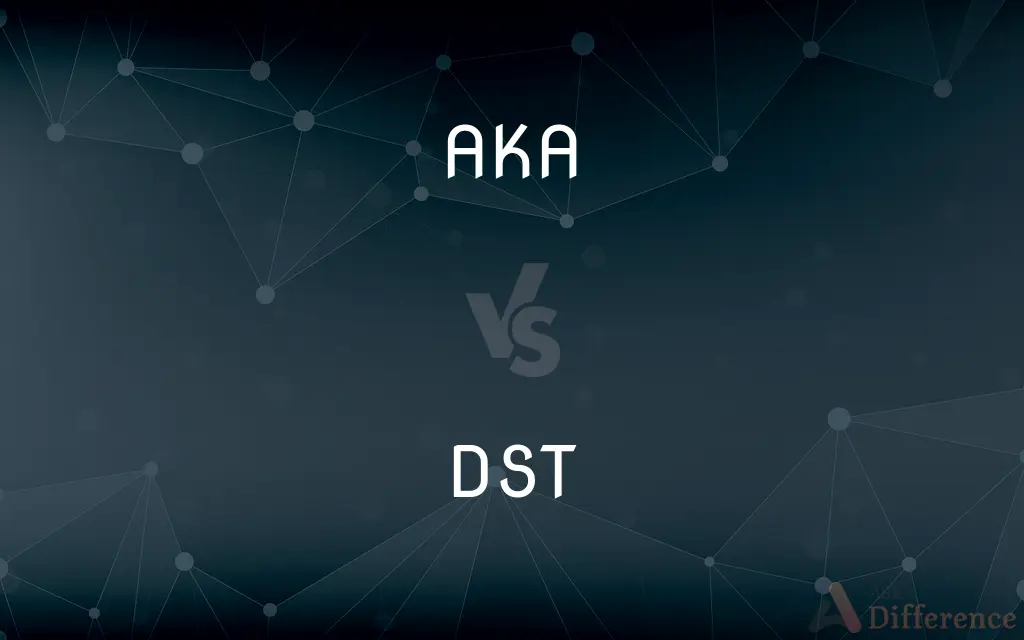AKA vs. DST — What's the Difference?
By Tayyaba Rehman — Published on January 16, 2024
AKA (Alpha Kappa Alpha) is the first historically African American Greek-lettered sorority, while DST (Delta Sigma Theta) is another prominent African American sorority, both with different founding dates, missions, and symbols.

Difference Between AKA and DST
Table of Contents
ADVERTISEMENT
Key Differences
Alpha Kappa Alpha (AKA) was established in 1908 at Howard University and is known as the first Greek-lettered sorority founded by African American college women. Delta Sigma Theta (DST) was founded later, in 1913, by former members of AKA, also at Howard University, with a focus on public service and social activism.
AKA emphasizes sisterhood, scholarship, and service to marginalized communities, and it is recognized for its iconic pink and green colors. DST focuses on empowering women and communities through advocacy, public service, and educational programs, and its colors are crimson and cream.
Both sororities have made significant contributions to civil rights and social causes in the United States. While AKA has programs like the "Emerging Young Leaders" initiative, DST has initiatives like the "Delta GEMS" program for teenage girls.
AKA and DST have distinct symbols and mottos that reflect their respective values and missions. AKA's symbols include the ivy leaf and the pink tea rose, whereas DST's symbols are the elephant and the purple violet.
Membership in both sororities is lifelong and involves a commitment to their ideals and community service. AKA and DST boast notable alumni, including influential leaders, activists, and public figures.
ADVERTISEMENT
Comparison Chart
Founding Year
1908 at Howard University.
1913 at Howard University.
Focus
Sisterhood, scholarship, service to communities.
Women's empowerment, public service, advocacy.
Signature Colors
Pink and green.
Crimson and cream.
Notable Programs
Emerging Young Leaders initiative.
Delta GEMS program for teenage girls.
Symbols and Mottos
Ivy leaf, pink tea rose.
Elephant, purple violet.
Compare with Definitions
AKA
Emphasizes sisterhood, scholarship, and service.
As an AKA member, I'm committed to community service and academic excellence.
DST
Prioritizes empowering women and communities through advocacy.
DST's programs are geared towards uplifting women and promoting education.
AKA
Symbolized by the ivy leaf and pink tea rose.
The ivy leaf represents growth and endurance in AKA's principles.
DST
Uses the elephant and purple violet as its symbols.
The elephant in DST's symbolism represents strength and determination.
AKA
Known for programs targeting leadership and community service.
AKA's Emerging Young Leaders initiative fosters early community leadership.
DST
A sorority founded with a focus on social activism and public service.
DST was instrumental in organizing events for social change and empowerment.
AKA
The first Greek-lettered sorority founded by African American college women.
AKA has a proud history of promoting education and service since 1908.
DST
Known for its Delta GEMS program for teenage girls.
DST's Delta GEMS program mentors young girls in high school.
AKA
Recognizable by its pink and green colors.
The pink and green colors of AKA were proudly displayed at the event.
DST
Identified by its crimson and cream colors.
At the parade, the DST sisters wore their traditional crimson and cream attire.
Common Curiosities
What are DST's signature colors?
Crimson and cream.
Are AKA and DST part of the Divine Nine?
Yes, both are part of the historically Black Greek-letter organizations.
What's the main focus of DST?
Women's empowerment and social activism.
What year was AKA founded?
1908.
Who can join DST?
College-educated women committed to public service and empowerment.
Is AKA open to all races?
Yes, AKA is open to women of all races.
What kind of events does DST organize?
Educational, advocacy, and community service events.
Are there notable alumni of DST?
Yes, including activists, politicians, and leaders.
What does AKA stand for?
Alpha Kappa Alpha.
What's a notable program by AKA?
The Emerging Young Leaders initiative.
What differentiates AKA from DST?
Their founding principles, history, programs, and symbols differ.
What symbolizes AKA?
The ivy leaf and pink tea rose.
What's the mascot of DST?
The elephant.
What are the ideals of AKA?
Sisterhood, scholarship, and service to communities.
How can one join AKA?
Through a formal recruitment and membership process in college or alumni chapters.
Share Your Discovery

Previous Comparison
Strong Bases vs. Weak Bases
Next Comparison
AMOLED vs. Super AMOLEDAuthor Spotlight
Written by
Tayyaba RehmanTayyaba Rehman is a distinguished writer, currently serving as a primary contributor to askdifference.com. As a researcher in semantics and etymology, Tayyaba's passion for the complexity of languages and their distinctions has found a perfect home on the platform. Tayyaba delves into the intricacies of language, distinguishing between commonly confused words and phrases, thereby providing clarity for readers worldwide.
















































